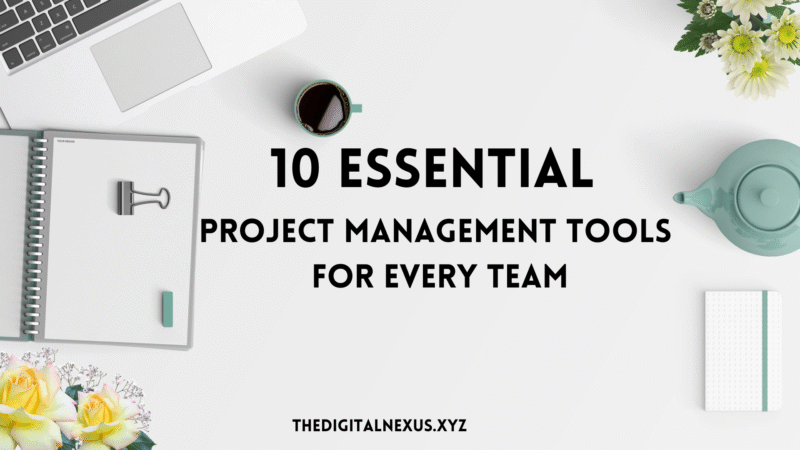Effective project management is the backbone of any successful initiative. Whether you’re a student coordinating a group assignment, an IT beginner joining your first development team, or a seasoned manager, the right digital tools can transform chaos into clarity. The modern landscape of project management tools is vast and varied, offering solutions for every team size, methodology, and budget. These platforms are more than just digital to-do lists; they are comprehensive hubs for collaboration, planning, and execution.
Navigating these options can be overwhelming. This guide simplifies the process, highlighting ten essential tools categorized by their primary strengths and providing a roadmap for beginners to select the perfect fit for their needs.
The Core Categories of Project Management Tools
Most tools specialize in a few key areas. Here are the most essential ones for modern teams.
1. All-in-One Work Platforms: The Command Center
These tools aim to be a single source of truth for all project-related activities.
- Monday.com: Highly visual and customizable, Monday.com excels at creating workflows for almost any industry. Its colorful interface makes tracking project status intuitive and engaging.
- ClickUp: Billing itself as “one app to replace them all,” ClickUp is a powerhouse of features, offering tasks, docs, chat, goals, and more in a single platform. It’s incredibly versatile but can have a steeper learning curve.
2. Agile and Development-Focused Tools: Built for Speed
For teams practicing iterative development, these tools are indispensable.
- Jira: The industry standard for software development teams using agile methodologies. Jira’s power lies in its deep integration with developer tools and its robust features for bug tracking, sprint planning, and creating roadmaps.
- Asana: While versatile enough for any team, Asana shines in managing complex workflows and dependencies. It helps teams see how their individual tasks connect to larger strategic goals.
–
3. Visual & Kanban-Style Tools: Simplicity and Flow
Perfect for visualizing workflow and managing tasks in a clear, linear fashion.
- Trello: The king of Kanban boards. Trello’s simple card-based system is incredibly intuitive, making it a favorite for individuals, small teams, and beginners managing straightforward projects.
- Notion: While more than just a PM tool, Notion’s flexibility allows you to build custom project management systems using databases, Kanban boards, and documents. It’s a fantastic all-in-one workspace for those who like to build their own tools.
4. Communication and Documentation Hubs: The Knowledge Base
Effective projects run on clear communication and accessible information.
- Slack: The leading team communication tool that replaces internal email chains with organized channels. Its integrations turn it into a notification hub for other project management tools.
- Confluence: Often used alongside Jira, Confluence is a team workspace for creating, sharing, and collaborating on project documentation, from meeting notes to technical specifications. For an external resource on knowledge management, check out Atlassian’s guide.
5. Traditional and Enterprise-Grade Tools
For large-scale projects with complex dependencies and resource planning.
- Microsoft Project: A long-standing leader in enterprise project management, known for its powerful Gantt charts, resource management, and detailed reporting capabilities.
- Wrike: A robust platform designed for enterprise teams, offering high-level security, advanced analytics, and customizable workflows to handle complex, cross-functional projects.
A Beginner’s Roadmap: How to Choose Your First Tool
For students and beginners, the sheer number of options is the biggest hurdle. Follow this simple plan to find the right starting point.
- Assess Your Immediate Needs: Are you managing personal tasks, a small group project, or learning for a future job? For individual or small team use, start with something simple like Trello or a free plan from Asana.
- Prioritize a Gentle Learning Curve: Don’t start with a complex tool like Jira or Microsoft Project. A tool with an intuitive, visual interface will allow you to focus on learning project management principles, not just the software.
- Leverage Free Tiers: Nearly every tool on this list offers a free version. Use them! Create a sample project and try to manage it from start to finish. This hands-on experience is the best way to see what clicks for you.
- Think About Integration: Consider the tools you already use. Does the PM tool integrate well with your cloud storage (Google Drive), communication app (Slack), or calendar? Good integrations save time and reduce friction.
Build Your Perfect Project Management Stack
No single tool can do everything perfectly. The most effective teams often create a “stack” of integrated tools—for instance, using Jira for development tasks, Confluence for documentation, and Slack for communication. As a beginner, start with one core tool and build from there as your needs evolve.
What are your go-to project management tools? Are there any hidden gems we missed? Share your recommendations and experiences in the comments below!
If you found this guide valuable, share it with your classmates, colleagues, or anyone looking to bring more organization to their projects.







